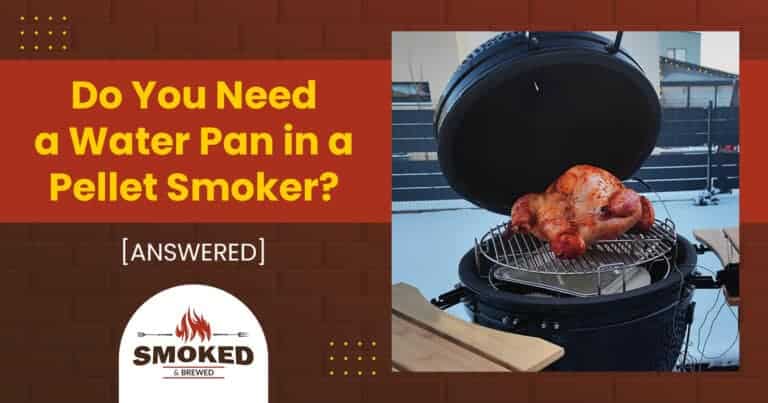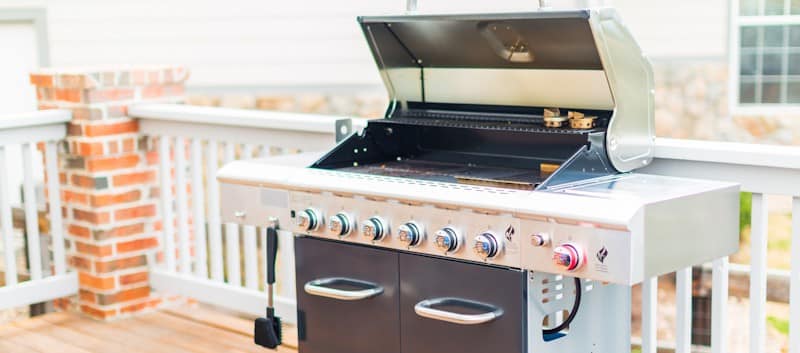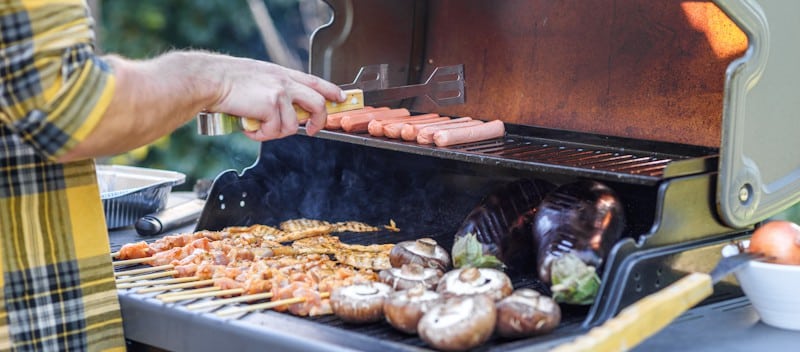If you’re upgrading from a standard smoker to a pellet smoker, you might wonder in which ways the cooking process will be different. You’ll have better temperature control and the ability to smoke larger quantities of meat, but does any of that make the classic water pan redundant?
You do not need a water pan in a pellet smoker because you can reduce the cooking temperature while getting significant smoke. The pellet smoker produces most of the benefits of the water pan more effectively, making the pan redundant. Still, you can use a water pan to improve moisture in lean cuts.
In this article, we will go over the potential drawbacks of using a water pan and the advantages of a pellet smoker so you can decide if you should keep the pan because it isn’t mandatory or should add it for a specific type of result. But before we discuss the differences in the results, let’s look at the role of the water pan.
What Does a Water Pan Do in a Smoker?
On average, a water pan helps regulate the smoker’s temperature and can enhance the flavor of the meat. It also helps keep the meat surface moist by producing a humid smoking environment. It is essential in smokers that are quick to heat and usually burn the leaner cuts of meat.
Starting with temperature regulation, two things need to be established. The boiling temperature of water is 212 Fahrenheit, and the target temperature for most meat smoking is 225 Fahrenheit. While crossing 225 Farenehit doesn’t automatically burn the meat, especially when the cooking surface has been properly oiled; it does lower the time you can keep the meat inside a smoker.
Suppose you’re smoking a lean cut for over 24 hours. The same cut in the same smoker for the same 24-hour period will come out burned or unburned based on how high the smoking temperature was. And smokers that do not have good temperature control because of poor grill mechanics or high residue build-up need something to reduce the temperature of the cooking environment.
Since water cannot cross 212 Fahrenheit (it becomes steam after that), having it in a pan directly below the meat (with the meat on a grill/rack atop the pan) or having it right next to the meat can keep the cut from reaching 225 Farenheit faster.
The next advantage of a water pan is that it can keep the meat moist. Again, this has a lot to do with the cooking temperature. If a piece of meat reaches a high temperature quicker and still has hours of smoking time left, the result will be a dry cut.
The physics behind this is the same as the one behind rare steak being juicier than a well-done steak. Since a water pan can reduce the temperature at which the meat is smoked, it can keep the meat from drying.
This makes one wonder if the pan is redundant in a smoker with excellent temperature control. Not really. The pan also serves to make the air around the meat more humid. The air can only handle a certain amount of water vapor before it resists further vapor injection. That’s why desert air is not infinitely humid even in the presence of bodies of water like an oasis.
Applying the same physics to a smoker, one can infer that after a while, the water vapor from the water pan can make the air so humid that it doesn’t have room for water vapor from the meat. This resistance keeps the moisture in the meat from turning into water vapor.
The final advantage of a water pan also extends from the steamy environment it produces. Water vapor attracts smoke, which ensures that the meat being smoked gets the maximum smokiness for the time it spends in the smoker. That’s quite a mouthful, but if the meat you smoke has its flavor enhanced with the presence of a water pan, you won’t mind several mouthfuls.
What Makes a Pellet Smoker Special?
Now that you know what makes a water pan so useful in a smoker let’s look at what pellet smokers specifically offer that can make a water pan redundant. And the chief among these is temperature control. Here’s how different aspects of a pellet smoker reduce the need for a water pan.
- Indirect heating – Because pellet smokers do not directly heat the meat, they are less likely to burn a cut. In terms of surface temperature control, this has the same effect as elevating a cut on top of a water pan by using a cooling rack.
- Better temperature control – Aside from the surface temperature of the cooking area, a pellet smoker can also give you more control over the cooking environment temperature. This means you do not need to rely on a water pan to keep the temperature below 225 Fahrenheit.
- More smoke for the heat – Since fire doesn’t have to produce smoke while directly heating the meat in a pellet smoker, you do not need excessive water vapor to attract smoke. It is produced separately using pellets and ushered into the cooking environment.
Using a Water Pan: The Potential Risks
Using a water pan doesn’t pose a threat to the meat, its flavor, and its texture, and in that aspect, you can always err on the side of more. You can use the water pan in addition to using a pellet smoker to have the perfectly smoked juice cut of meat. However, when you use a water pan, you must remember that it has one potential risk.
A water pan contains boiling water that takes a lot longer to cool down than the rest of the smoker. This has a potential risk and can cause serious injury if spiller. The cooking surface that houses the pan cools down by transferring heat to the pan, so you have to be mindful when emptying the pan.
Final Thoughts
A pellet smoker doesn’t need a water pan though spraying water over the meat helps keep it moist and prevents the fat from burning. Pellet smokers provide better temperature control and smoke ratio than a water pan, making them redundant. However, using the pan will not have an adverse impact on the smoking process, so if you have a water pan at home, you might as well use it.
Scot has loved smoking food in his free time for the last few years. Each major holiday or off-weekend, Scot spends days testing and prepping new recipes for perfection.



